► We drive an updated Golf R prototype
► It’s (slightly) faster than before
► And considerably easier to live with
Volkswagen is slowly working its way through the Golf range, revising each model as it goes. We’ve already witnessed the facelifted versions of the standard hatch, the GTI and the GTI Clubsport – and we saw that they were good. Now, though, Volkswagen is preparing to update my favourite version of the car. The range-topping Golf R.
The car isn’t quite ready for its market launch yet, but Volkswagen was so proud of its handiwork it flew us out to Germany to have a blat in a pre-production prototype. The finished article will hit the UK market in autumn 2024 sporting some mild cosmetic tweaks, a smattering of performance enhancements and some much-needed technology improvements inside.
I’ll admit, I was a little concerned on the outbound flight. I knew this facelift had the potential to make a good car great – and I desperately didn’t want to return from my trip disappointed. Happily, early impressions are encouraging. I shouldn’t have worried. Even though the car I drove was unfinished, it felt like a significant improvement over the outgoing model. Scroll down to find out why.
At a glance
Pros: Better infotainment, pseudo anti-lag technology, still great to drive
Cons: Steering feel could be better, exhaust note is incredibly muted
What’s different?
If I’m honest, a little less than I was expecting. Save for some new lightweight wheels and a larger rear wing, the exterior styling is almost identical to the old car. Volkswagen hasn’t made any significant changes to the chassis, either. Most of the enhancements were achieved through laptop tinkering rather than good old-fashioned engineering.
Still, there was obviously a bit of headroom left in the Golf R’s platform because Volkswagen’s boffins have managed to safely eke some more performance from it. I still feel like that 2.0-litre four-cylinder engine has a lot left to give but Jonas Thielebein, one of Volkswagen’s development drivers, told us he didn’t feel comfortable pushing the engine any further while still sending off to customers it with the same warranty.
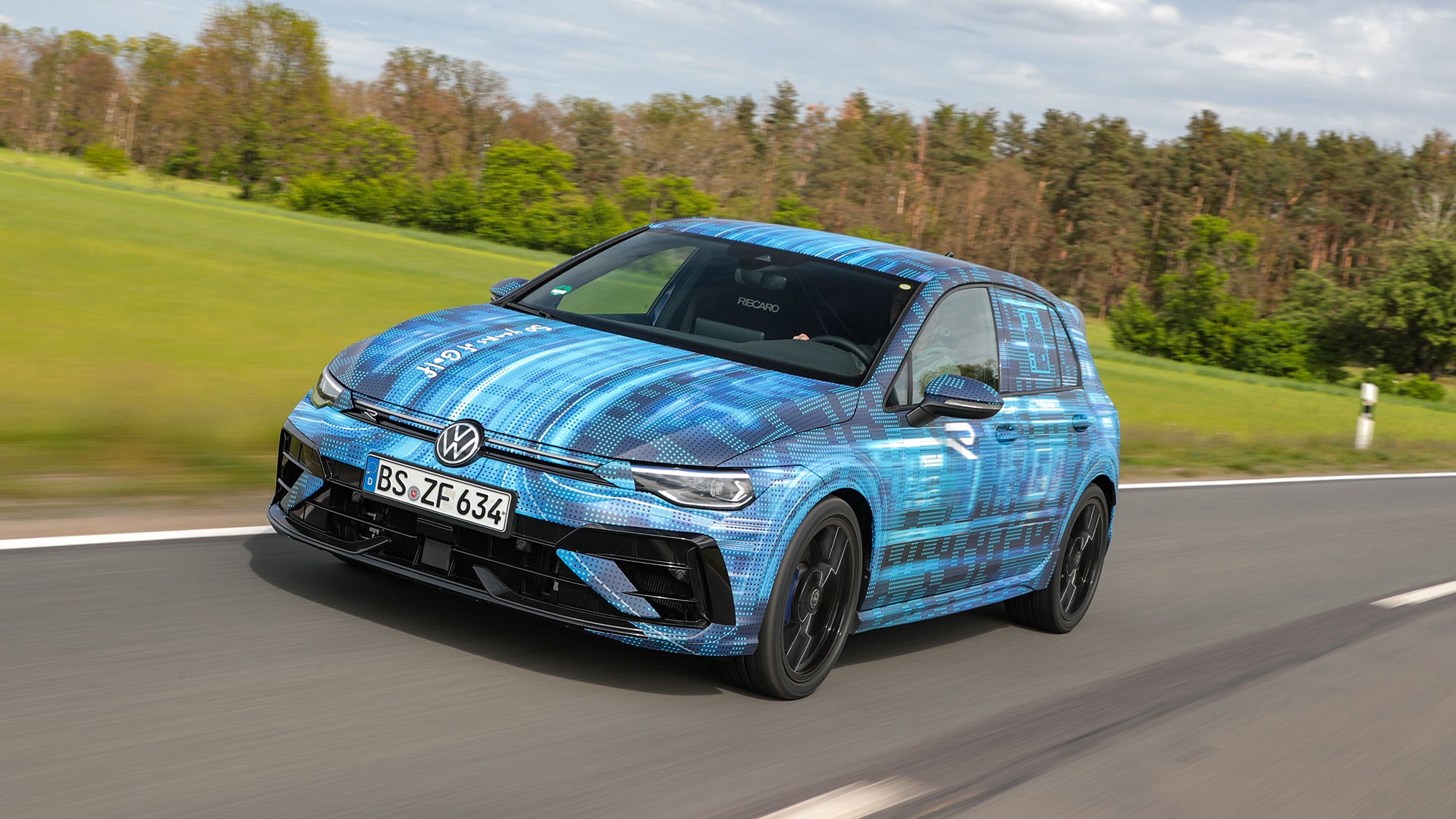
So, with that in mind, Volkswagen has given the R a modest power increase from 316bhp to 328bhp. That’s only a 3.7% improvement – and the car’s torque figure remains the same at 309 lb ft – so you need to concentrate quite hard to notice the difference. But more power is always more better in my book, even if it is just for bragging rights.
Volkswagen wasn’t really concerned about the R’s peak power for this update, though. It was more focused on its drivability – and the changes it made to the car’s turbocharger have benefited that dramatically. Volkswagen’s software wizards have sprinkled some magic on the wastegate profile, forcing it to hold onto more pressure when you lift off the throttle to trim lag and improve response. And hell, does it work well.
Thielebein showcased the tech with a static demonstration. It’s only active when the car is running in ‘R’ mode but, at tickover, the engine’s resting boost pressure more than doubles from 0.3 bar to 0.8 bar thanks to the new tuning. In old money, that’s a jump from 4psi to 11psi. I’ve driven old-school turbo cars that can’t make 11psi at full chat in third gear, so that’s an impressive feat.
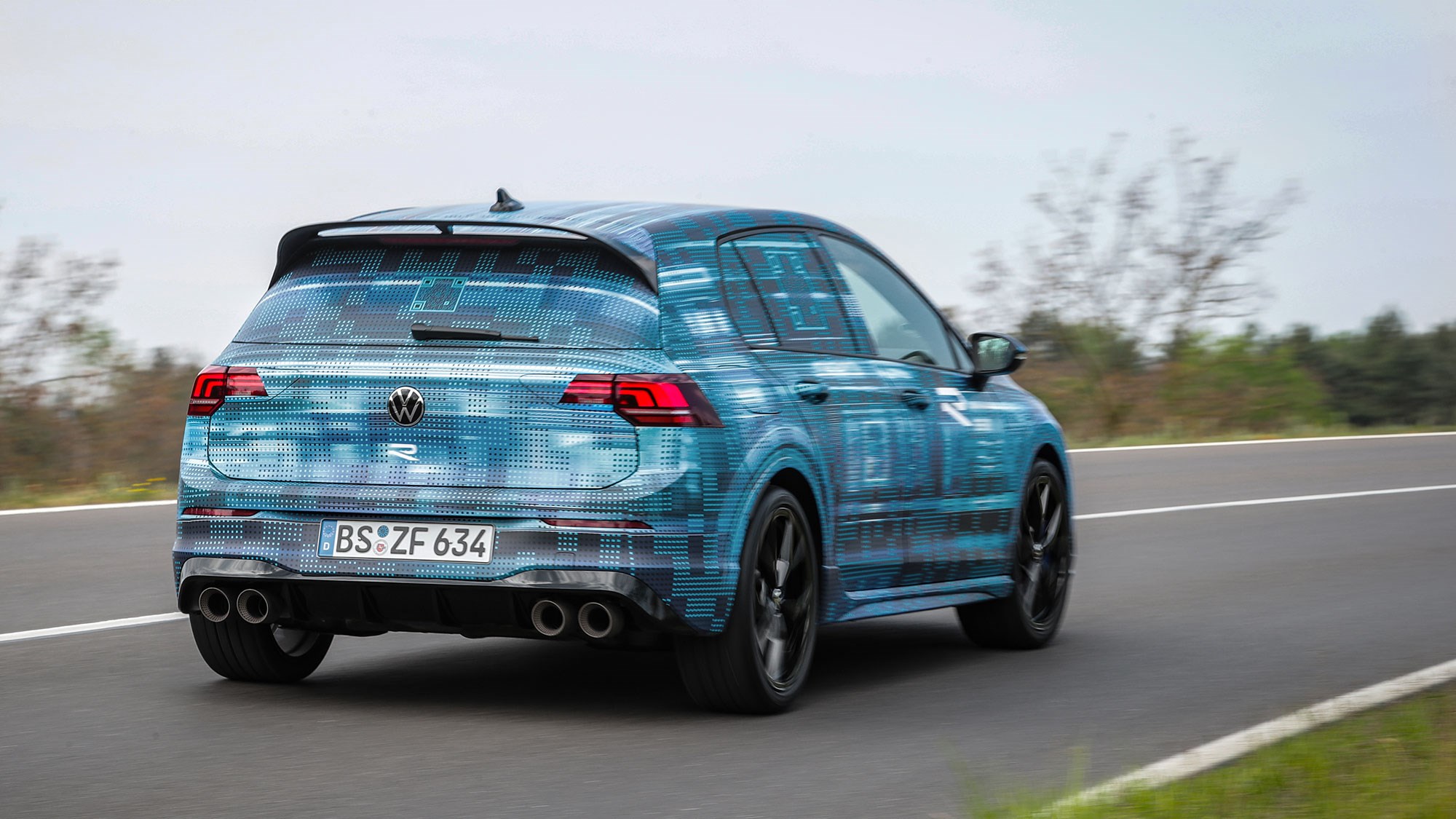
It’s even more impressive on the road. Switch the car into ‘R’ mode and you can feel the engine race forwards as the boost pressure spikes. It’s almost like having anti-lag – the throttle is far more eager in the lower half of the rev-counter thanks to the new boost map, allowing you to access more of the engine’s power more of the time.
That means the Golf R now feels fast at sensible speeds. The previous version of the car only started to come alive when you were challenging the limits of physics.
What about the interior?
Naturally, Volkswagen has also made some subtle tweaks the Golf R’s interior. We’re not allowed to show you any pictures of the car’s updated cabin yet, but we can confirm that it’s been fitted it with the same 12.9-inch infotainment system and sensible backlit climate sliders found on the standard facelifted Golf.
The touchscreen is a vast improvement over the old system, as it has a far simpler menu layout, much faster load times and an incredibly helpful shortcut bar at the top of the screen that allows you to jump directly to the driver assistance menu rather than wading through countless menus. That means disengaging lane assist now take two prods rather than half an hour of poking, waiting and swearing.
Volkswagen hasn’t given the R the same steering wheel as the standard revised Golf, though. Rather than some sensible physical buttons, you get the same haptic wheel as before, which almost upset me when I first encountered it.
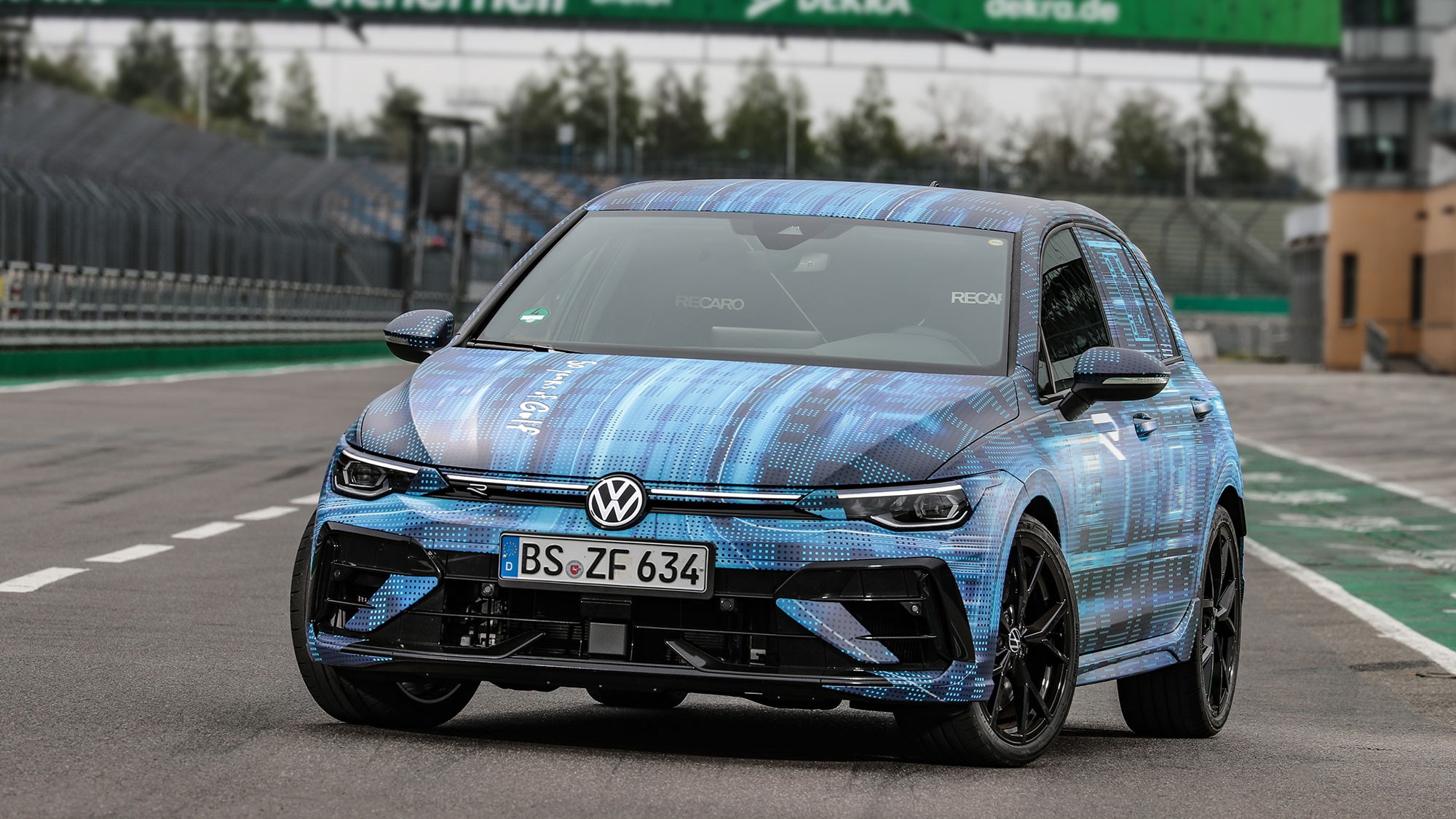
The wheel was one of my least favourite bits of the old R because the buttons for the ‘R’ mode and heated steering wheel fall directly under your palms if you drive with your hands at 9 and 3 (which is where they should be if you want to drive quickly correctly). That meant you could accidentally switch drive modes or flame grill your hands on a spirited drive.
Thielebein shared my frustration – he told me that, when he was testing the previous version of the car at the Nurburging, he and his team would mis-press the buttons at least once every 20 laps, often dumping the car into Comfort mode halfway around one of the carousels.
It was far too expensive for Volkswagen to engineer an entire new steering wheel specifically for the R, but the brand’s laptop wranglers have at least changed how the haptic buttons work. Now, you can’t activate them by merely stroking them with your finger – you need to drive your thumb into the pad like you’re trying to push a six-inch nail through a block of polystyrene.

It’s way better. I didn’t accidentally push the buttons once during my drive. Thielebein also said that he conducted 250 laps of the Nurburgring in the new car without a single mis-click. That’s a glowing recommendation if I ever heard one.
What’s it like to drive?
I should preface my opinion with some context. The car I drove was almost a race car. It had Recaro seats, racing harnesses, a roll cage, and barely any interior. That’s because Volkswagen will soon use the same car to try and beat the outgoing Golf R’s lap record at the Nurburgring, hopefully putting the Honda Civic Type R’s nose out of joint at the same time.
These changes mean the car I drove was slightly stiffer, lighter and therefore quicker than the car you’ll be able to buy from your local Volkswagen dealer later this year. Still, I could feel the difference in the sum of the tweaks Volkswagen has made to the car – and they add up to make the new R better than before.
The turbocharger fixes are a game changer. Peak torque now arrives at 2100rpm and stays strong until you reach 5500rpm, which means the facelifted car feels far more flexible than the old one. Acceleration is a little more visceral, too, thanks to the broader torque curve.

I was accompanied on my drive by one of Volkswagen’s maniacal test pilots, who took me for a jaunt down one of the unrestricted sections of the Autobahn. He told me to put my foot flat on the firewall as we joined the slip road, and he wouldn’t let me lift off until we hit our exit. And the little Golf flew.
0–62mph is now dealt with in 4.6 seconds and, flat out, the R will hit 167mph. I was grazing the V-max on the German motorway, too – we hit 157mph before I ran out of Autobahn and had to lay into the car’s excellent brakes to avoid clattering into the back of a wayward articulated wagon.
What’s particularly impressive is that the engine was still pulling strongly at that speed. Plus, the chassis was remarkably planted, despite the fact I was travelling at the take-off speed for a commercial airliner. It barely felt like I was doing 100mph.
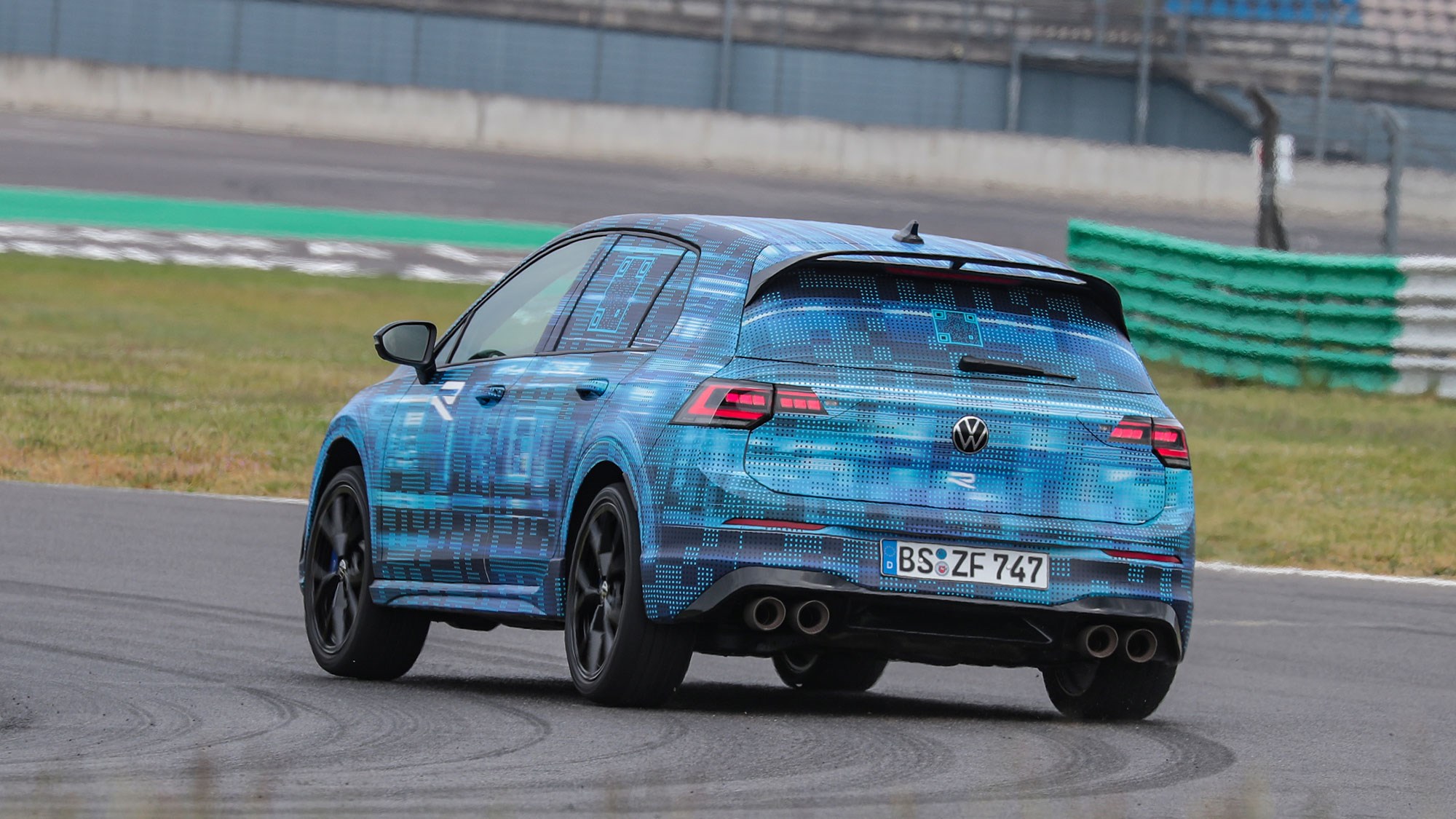
I didn’t get chance to carve many corners in the prototype, but my minder did encourage me to take one of the slip roads on my route at speed – and the experience told me a little bit about the car’s performance at the limit. It was a sharp right hander with a lump in the middle which unsettled the rear of the car, but I could quickly tame the wiggle with a dash of opposite lock and a boot full of power. It’s predictable, just as it should be.
I’m a little disappointed Volkswagen didn’t do anything about the way the Golf R sounds, though. I know it’s supposed to be the ultimate do-anything hatchback, so a straight-pipe would quickly get tiresome on the motorway. I’ve never liked how muted the R sounds, though – and, somehow, the new one is even quieter.
Volkswagen’s excuse was that there are strict EU regulations on how noisy cars can be. The cap is set at around 70 decibels for new cars, so Volkswagen had to pack the R’s exhaust with cotton wool and pillow fluff to dampen the sound or face the wrath of the EU’s legislators. Again.
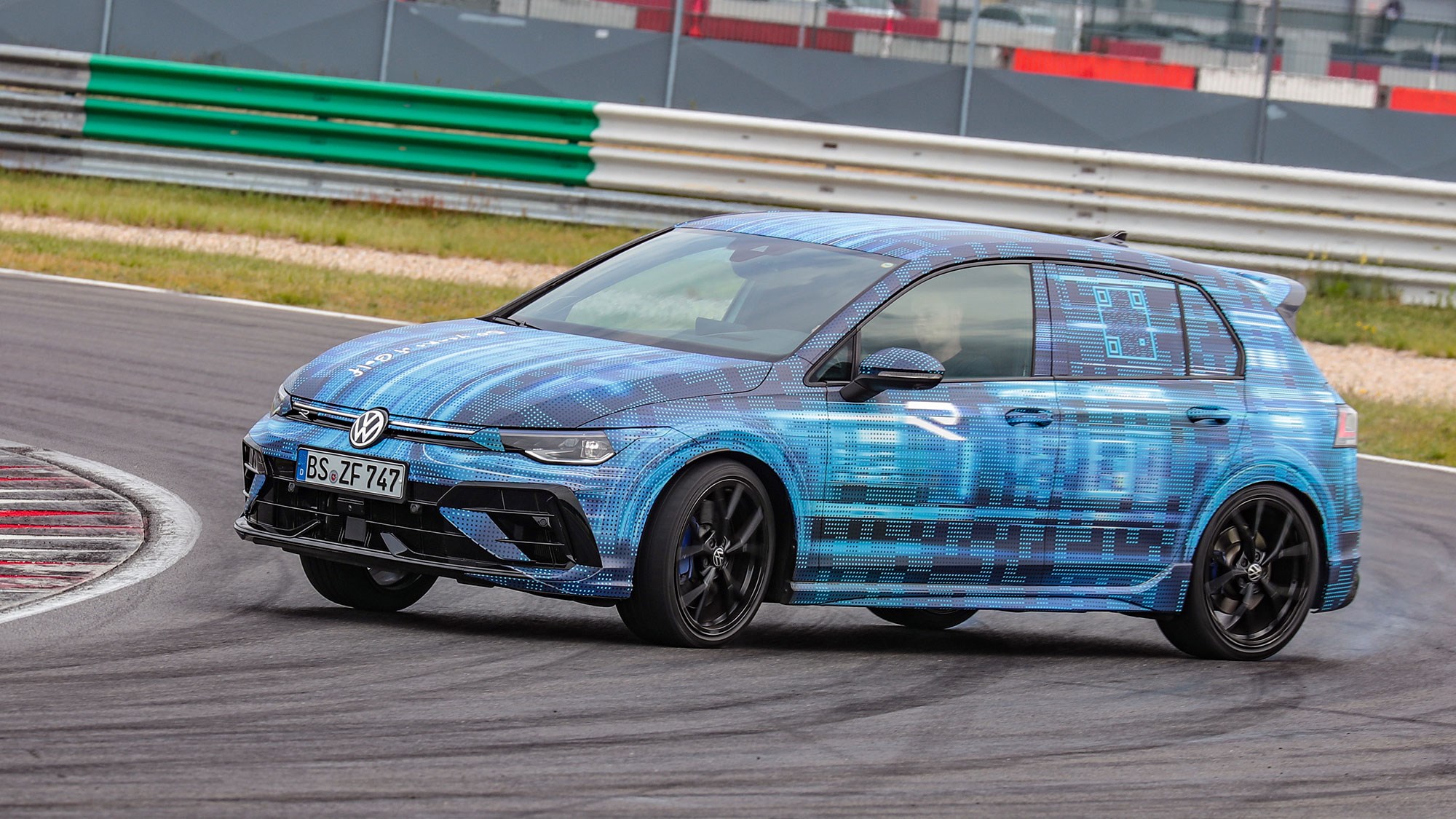
I think it’s daft. I can shout louder than 70 decibels, for heaven’s sake. Plus, the Golf R is a hot hatch. It’s supposed to be obnoxious and offensive. If I was to buy one with my own money, the first thing I’d do is cut the resonators out of it and fit a rortier back box.
Verdict
It’s hard to draw a conclusive verdict from my rather short drive in the facelifted Golf R. The prototype I was handed wasn’t exactly production spec, but I’d be lying if I said it wasn’t an improvement. The engine is far more eager than before, which really helps to boost the excitement factor at slow speeds – something that was sorely missing.
Despite this extra focus and excitement, the new Golf R retains all the characteristics that made the old car such a joy to live with. The handling is just as unsurprising as before when you’re hammering down a B-road and, if you want to take it to a track, you get the same toy box of enthusiast aids, including a clever torque vectoring system and a drift mode. Plus, it’s equally comfortable when you’re commuting.
The new infotainment has made the interior a far nicer place be, too. You can access the driver assistance menu far easier than before, and the additional processor speed means you can swap between the sat-nav and climate screens without fearing about missing your next exit.

I’m pleased that Volkswagen has addressed our concerns with its touch-sensitive controls, too. It’s great to see a car company take constructive criticism from its customers and react in a positive way. And I loved not having to shout at the car for kicking itself out of ‘R’ every time I went around a right-hand bend.
We need to get a production-spec car on British tarmac before we can make our final verdict, but first impressions are heartening. The improvements are especially welcome now that Volkswagen’s R division is looking to shift its focus towards electric cars. This could well be the last hurrah for the petrol-powered Golf R – so it’ll be nice to watch this icon bow out on a high note.
Watch this space. We’ll update you with our full review soon.